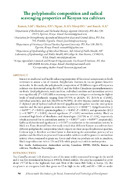| dc.description.abstract | Interest in medicinal and health enhancing properties of functional components in foods
continues to arouse a lot of interest. Polyphenolic fractions in tea are potent bioactive
molecules. In this study, the polyphenolic composition of 25 different types of Kenyan tea
cultivars was determined using the HPLC and the Folins Ciocalteus spectrophotometric
methods. Total polyphenols, total catechins, individual catechins and antioxidant activity
were significantly (P < 0.05) different among tea varieties, with green tea having the highest
levels of total polyphenols ranging from 19.70% to 26.12%, TC (8.51% to 17.60%),
individual catechins, and AA (86.65% to 94.50%). In vitro bioassay carried out using 2,
2'-diphenyl picryl hydrazyl radical showed epigallocatechin gallate was the most potent
catechin and the most potent in antioxidant activity (r = 0.968***). Epigallocatechin (r
= 0.659***, P < 0.001), epicatechigallate (r = 0.454*, P < 0.001), and epicatechin (EC)
(r = 0.780***, P < 0.001), showed significant (P < 0.05) antioxidant activity. Black tea
contained high levels of theaflavins and thearubigins (2.072% to 17.12%), respectively
which accounted for its antioxidant activity (r = 0.803*** and r = 0.859***, respectively).
Gallic acid also showed significant (r = 0.530*) contribution to the antioxidant activity in
black tea. Data obtained from this study reveals that different Kenyan tea cultivars have
different polyphenolic composition which imparts on their unique biochemical qualities.
Cultivar type is therefore a critical factor in determining the antioxidant potency of tea
product and that black tea processed from suitable cultivars could be potent in antioxidant activity when compared to green tea. Green and white tea products are rich in catechins, black tea products are rich in TFs and TRs while purple tea is rich in anthocyanins. | en_US |
